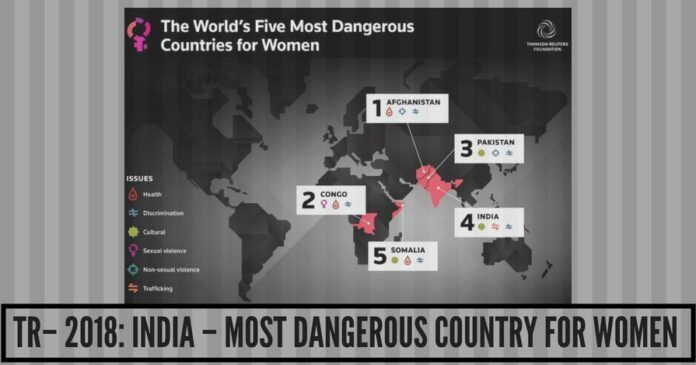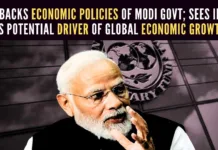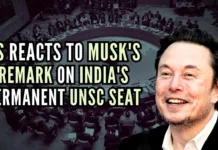
I tried to dig a bit deep into the culture of Thomson Reuters since they used “Culture” as one of the parameters for evaluating the threat to women in India
I was baffled by this headline and survey done by Thomson Reuters (TR) and the subsequent lapping up of this “analysis” by media all over the world, including the CNN even though USA figures in the top 10 list. I could understand CNN’s glee because it is clearly an anti-establishment platform fighting the likes of Fox News with which the entire Trump Administration shares its bed. TR also mentions that this was based on findings by 500 odd “experts” at TR. So I tried to dig a bit deep into the culture of TR, since they used “Culture” as one of the parameters for evaluating the threat to women in India.
Interestingly as of 2018, half the revenue of TR comes from the Financial & Risk division and not News. So I could quickly figure out who the so-called “500 experts” could be
From its inception in Britain, Reuters, after changing hands to another British company had pioneered many ways of gathering news using technology like Radio. In fact, it is credited as the first News agency reporting the assassination of Abraham Lincoln.
I knew there was a company called Thomson which bought the majority stake in Reuters and the combined entity was no longer only a News agency but diversified.
Historically, no single individual has been permitted to own more than 15% of Reuters, under the first of the Reuters Principles, which states, “Reuters shall at no time pass into the hands of anyone’s interest, group or faction”. However, that restriction was waived for the purchase by Thomson, whose family holding company, the Woodbridge Company currently owns 53% of the enlarged business. Pehr Gyllenhammar, chairman of the Reuters Founders Share Company, explained that the Reuters Trust’s First Principle had been waived for the Thomson family because of the poor financial circumstances that Reuters had been in, stating, “The future of Reuters takes precedence over the principles.”
Robert Peston, a business editor at BBC News, stated that this has worried Reuters journalists, both because they are concerned that Reuters’ journalism business will be marginalized by the financial data provision business of the combined company, and because of the threat to Reuters’s reputation for unbiased journalism by the appearance of one majority shareholder
The company in 2014 was organized around eight divisions across financial, media, legal and science industries
- Financial & Risk
- Legal
- Pharma & Life Sciences
- Reuters News Agency
- Tax & Accounting
Former divisions:
- Intellectual Property
- Scholarly & Scientific Research
Interestingly as of 2018, half the revenue of TR comes from the Financial & Risk division and not News. So I could quickly figure out who the so-called “500 experts” could be. They must be a beleaguered lot of the so-called Scholarly and Scientific Research Division. – the bottom feeders of the Data scavenging machine at TR, trying to go up the ladder. It is called “Growth” in business parlance.
Next, I wanted to see what were all the parameters considered by TR’s Experts. Perhaps they were ex-colleagues of prior divisions, retained after reorganization and were able to get some scrap data from those divisions using their clout to try and make a mark in the organization. TR as a company is now Canadian and not British. The British either exit or divide anything they conquer leaving everyone with a complex language while the Canadians don’t lock doors of their own homes even at night and use immigrants to warm up their cold country with their bodily heat – no, I am not referring to Sunny Leone.
So here are those parameters and a brief description of the areas which were used for concluding their report followed by my own views:
Healthcare
This includes general health access to optometrists, dentists, general doctors and specialist doctors who have expert knowledge in disabilities, diseases or dealing with trauma.
My view: So women in India make the list for inability to access general doctors and those doctors who have “expertise knowledge” in disabilities, diseases or trauma. It does not say they are unable to buy glasses, remove the root canal, buy walkers or other such devices and handle trauma through Yoga. By “expertise knowledge” I am presuming they mean specific conditions such as glaucoma, cataract, dentures, psychiatrists etc., 50% of India’s women population do not need such “expertise” in 2018. They are below 35 and are energetically focused on watching TV Serials, raising kids, buying new phones every year, partying and spending money on street food, fashion, entertainment or paying for average Internet Data connection speed to gossip or consume information put out by companies like TR. 20% of females are children, 90% of whom get everything for free. The rest mostly are voluntarily retired people or housemaids who are strong enough to get some work or live on savings. I think TR used their experts to talk to people who were only 70+, many of whom are unable to see properly, have no use for dentures other than for gossiping with housemaids, have hearing problems, demented or cynical. What do they expect from such people? Sleep around with other younger ones like Trump does? 90% of these 70+ old folks in India are busy complaining to their wards instead of living peacefully in old age homes.
We find that such medical technologies also affected Europe where even the general population declined – not just the girl population
Discrimination
This includes job discrimination; an inability to make a livelihood; discriminatory land, property or inheritance rights; a lack of access to education and a lack of access to adequate nutrition.
My view: 50% (35 years or less) of Indian women don’t want to eat food because there is a South Asian specific gene in them that makes fat accumulate mostly in their abdomens. So they are happy with any livelihood including working for BPOs like TR at 2 AM in the morning. 90% of almost all girl children get midday meals at schools. Many Indian youths work as what Canadians call as “Au pair” or nurses within and outside India and mostly subjected to harassment while abroad. But orphaned children in the West live in foster homes with unqualified parents who proactively seek such income from the State, get educated in free schools that have unemployable teachers, all of which in turn tax the poor more than the rich. Women below 70 in India raise children, grandchildren, read magazines, make YouTube videos of recipes for the younger generation, become very religious, continue with yoga or eke a living as housemaids mostly by harassing the people who employ them. Housemaids also get free coffee, food, tuition fees for their children as perks, flexible work timings and paid absence. Only the 70+ are in a tricky situation because their wards’ patience is tested with regards to property and inheritance rights.
Cultural Traditions
This includes acid attacks; female genital mutilation; child marriage; forced marriage; stoning, physical abuse or mutilation as a form of punishment/retribution and female infanticide.
My view: I would like to focus on India specific issues only and not comment about some of the above traditions that are followed elsewhere.
In a strongly patriarchic society, such things are bound to happen whether in the West or East. Though we managed to abolish Sati and Bride burning due to unfulfilled dowries on our own, we failed horribly to maintain proper gender ratio after Independence due to improvement in abortion facilities.
We find that such medical technologies also affected Europe where even the general population declined – not just the girl population. Raising a son was the best Indian fathers could manage with limited resources whereas raising any child was considered a burden in Europe even after decimating themselves by starting two World Wars. It looks like many Europeans took our Indian dharma very seriously and did not want to bring another new human soul into this world after having experienced the horrors of wars fought across continents. Whereas India was busy raising more sons to improve chances of surviving after the brutal famines that hit us during those wars.
Nobody can justify such acts especially Indians who worship women. I read somewhere that Indian men allowed women to wear blouses as it was a lifestyle change imparted to us by the British from the Victorian era. Until then we never heard of the word “Cleavage” that causes men to ogle at women.
Having said that we should also note that acid attacks in India are happening regularly because of this skewed gender ratio. Not many partnerships are happening and resulting jealousies are the reasons. Even a former lady CM who was a well-read person was suspected of instigating an acid attack on a lady IAS officer due to poor mental health caused by patriarchy. IMHO, child marriages have started in India again only to ensure such drastic acts of jealousies don’t occur. Though the West is magnanimous in attributing India for their innovation in Math, like discovering the Zero, they seem to be harsh in evaluating our culture that is liberal and takes its course like a river – finding an easy path only to end up in the ocean like any other river.
I also believe physical abuse of women are meted out but reported less throughout the world and not just in India. The Anti Dowry act in India was also a positive step but seems to have been totally ignored by the western media while harping only on the #MeToo movement.
Sexual Violence
This includes rape as a weapon of war; domestic rape; rape by a stranger; the lack of access to justice in rape cases; sexual harassment and coercion into sex as a form of corruption.
Nothing much to add about India apart from the reasons mentioned in the previous section. Canada has never faced the kind of wars our women faced due to invasions. Canada can maintain high moral ground by only naming their cities in honour of their vanquished natives, while we were doing things the other way around. At least they are admitting that there is only lack of justice and not lack of law in India. As regards to Cand coercion, I believe Indians only had casting beds and not couches. We call couches as sofas and ours are too small for any kind of Kamasutra posture. Sometimes I wonder why there was a drastic reduction of rape “reported” in the USA (a country that proudly claims Justice as one of the cornerstones of its founding) only after they decriminalized LGBTs. Why can’t TR focus on the ensuing HIV holocaust caused by their neighbour instead of conducting “deep research” about post-Colonial Governments that provided and still provide manpower sustenance to them? The so-called third world countries helped the West’s condom industry by tapping their rubber trees. But now those countries are losing that business also because some Western wisecrack found a way to create artificial rubber from crude oil and helped corrupt the environment using sexual corruption.
The other 2 parameters, Non-Sexual Violence and Human Trafficking, are described as conflict-related violence, domestic, physical and mental abuse, domestic servitude, forced labour, bonded labour, forced marriage and sexual slavery for which no western country has the moral right to comment upon any of the Asian, African countries in the list.
Lastly, I want to add this: It might be difficult to implement Vegas-style “Drive Through” marriages in India instead of forced marriages due to traffic congestions in India.
Note:
1. The views expressed here are those of the author and do not necessarily represent or reflect the views of PGurus.











Mohan,
This article is filed under “Opinions”. You are more than welcome to state your opinion about my opinion.
Thomson Reuters has itself admitted that the survey was based on perception. Whom did they approach for “their research” for getting this perception is the moot point.
Please read my article in entirety instead of focussing on the “garbage” put out by Thomson Reuters by saying one of their parameters in the survey was Healthcare. If doctors are badly accessible to Indian women why are patients from the West keen to come here under “Medical Tourism” ?.
India knows how to correct itself and when. Today our female population is catching up only because we corrected ourselves and made it a crime if doctors disclose the gender of the fetus as it led to sex-selective abortion. We don’t need such pseudo intellectual garbage from the West to highlight our shortcomings to help politicians or mainstream media to use it for revenue generation while conveniently ignoring efforts made by us to thwart these crimes.
Ramesh
I normally Like Sree Iyer’s commentary in PGuru’s; however, this Ramesh Iyer seems to find fault with the study, without giving credit for the well-researched work done by the authors. Instead of looking inwards into Indian Society, and finding shortcomings which the authors have highlighted, Ramesh looks tangentially into what may be wrong with the west. It is a fact that Indian women are treated badly in this 21st century. Whether they are treated the worst, or just a little bit better than the worst country is just semantics. India needs to improve tremendously in this aspect of treating women. Otherwise they will lose 50% of the population, who can help to make India a first world country.
Ramesh needs to do a lot of Introspection on the garbage that he spews in this article, instead of sullying the reputation of PGURUS otherwise wonderful commentaries on the state of politics and corruption in society.
Mohan
Mr Chellani,
I hope you do agree with Prof Vaidyanathan’s video interview with Sree Iyer in which he says Thomson Reuters admitted the survey was done on perception and not on your so called “well-researched work done by authors”. Whom did they approach for “their research” for getting this perception is the moot point.
My garbage is the same as this survey. That is the point I was trying to make with my sarcasm and views.
Reuters itself has admitted that it no longer values it’s principles and I have quoted that also. Please read my article in entirety instead of focussing on the “garbage” put out by Thomson Reuters by saying one of their parameters in the survey was Healthcare. If so why do people from the West come here for medical tourism ?. If I was intent on sullying PGurus it would not be published in the first place. I hope you know that PGurus has an editorial panel. It says clearly that the views are those of mine and not PGurus.
Bharath knows how to correct itself. Today our female population is catching up only because we corrected ourselves and made it a crime if doctors disclose the gender of the fetus.
We don’t need such pseudo intellectuals to highlight our shortcomings instead of giving solutions , proactively.
Ramesh